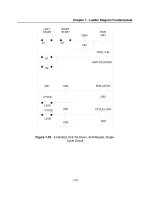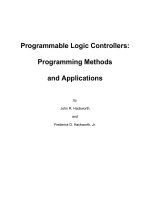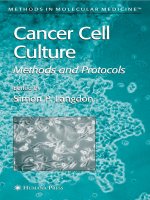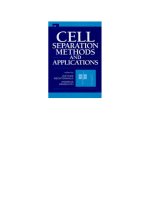cell separation methods and applications
Bạn đang xem bản rút gọn của tài liệu. Xem và tải ngay bản đầy đủ của tài liệu tại đây (16.15 MB, 346 trang )
Page i
Cell Separation Methods and Applications
edited by
Diether Recktenwald
AmCell Corporation
Sunnyvale, California
Andreas Radbruch
Deutsches Rheuma-Forschungszentrum Berlin
Berlin, Germany
Page ii
Library of Congress Cataloging-in-Publication Data
Cell separation methods and applications / edited by Diether Recktenwald, Andreas
Radbruch.
p. cm.
Includes bibliographical references and index.
ISBN 0-8247-9864-3
1. Cell separation. I. Recktenwald, Diether. II. Radbruch, A. (Andreas)
QH585.5.C44C435 1997
571.6—dc21 97 -33113
CIP
The publisher offers discounts on this book when ordered in bulk quantities. For more information, write to
Special Sales/Professional Marketing at the address below.
This book is printed on acid-free paper.
Copyright © 1998 by MARCEL DEKKER, INC. All Rights Reserved.
Neither this book nor any part may be reproduced or transmitted in any form or by any means, electronic or
mechanical, including photocopying, microfilming, and recording, or by any information storage and retrieval
system, without permission in writing from the publisher.
MARCEL DEKKER, INC.
270 Madison Avenue, New York, New York 10016
Current printing (last digit):
10 9 8 7 6 5 4 3 2 1
PRINTED IN THE UNITED STATES OF AMERICA
Page iii
FOREWORD
It should not come as a surprise that the fields of developmental biology as an intellectual discipline and cell
separation as a technological discipline have grown in an interdependent fashion. Just as the cell is the unit of
biological organization, cells are organized into groupings from the most mature effector cells back to the most
primitive progenitors-the stem cells. Stem cells and progenitor cells have the capacity of being clonogenic
precursors for large numbers of progeny; stem cells are the most primitive subset and are defined as the cells
that can both self-renew and at the single-cell level give rise to progeny of several different mature cells.
Progenitors may be multipotent or oligopotent and can be distinguished from stem cells by their lack of self-
renewal capacity. The generation and regeneration of all tissues in the organs in the body depend on the actions
of stem and progenitor cells. When we think of generation, we think of those events that occur in embryonic
and fetal life to give rise to the organ systems; and when we think of regeneration, we think largely of repair
systems, which, in the end, can or should be exploited clinically to replace, wholly or in part, tissue and organ
systems that are damaged or are defective.
Identification of the stem and progenitors cells involved in generation or regeneration of a particular organ
system or tissue concerns fairly rare populations. When one is dealing with regeneration of tissue or organ
systems in a clinical circumstance where diseased or malignant cells may contaminate that organ system,
practical regeneration can occur only if the stem/progenitor cells
Page iv
are purified nearly to homogeneity and do not contain contaminating diseased cells. To do this not only in
animal models but in humans, one must be thinking of separation technologies that not only are high fidelity in
terms of identifying and isolating rare populations, but also are on a scale that is large enough to deliver
adequate numbers of stem/progenitor cells for clinically effective and rapid regeneration.
As an immunologist, I must also add that large-scale identification and separation of subsets of cells of the
immune system for experiment and clinical treatment involve clonogenic cells of another sort-lymphocytes that
respond to antigen by clonal expansion and differentiation into memory or effector cells. Because most
methods that allow the culture and expansion of these important potential effector cells also alter their life-span
and homing properties to the extent that normal regeneration of the immune system cannot occur, again large-
scale high-fidelity separations are required.
Within this exciting volume two masters of cell separation technologies, Diether Recktenwald and Andreas
Radbruch, have gathered together the most accomplished researchers at the leading edge of several cell
separation technologies. It is fitting that there is input from the commercial arena, as the development of these
technologies as research tools and as clinical scale separation devices can only come through entrepreneurial
and commercial efforts. These articles collectively provide the technological and scientific basis for advancing
cell separation and identification technologies, and I commend them to you as the state of the art just prior to a
new era when this marriage of cell, developmental, and cell separation technologies is about to transform
medicine and, at the same time, reveal new insights into the cell and molecular biology that allows stem and
progenitor cells to be just that.
IRVING WEISSMAN, PH.D.
DEPARTMENT OF PATHOLOGY
AND DEVELOPMENTAL BIOLOGY
STANFORD UNIVERSITY
STANFORD, CALIFORNIA
Page v
PREFACE
The need for ever more powerful methods in cell separation has grown tremendously with the identification of
many specialized cell subsets because of rapid progress in cell biology, immunology, and molecular biology.
This book on Cell Separation Methods and Applications describes all of the important methods for the
analytical and preparative isolation of specific populations of biological cells. In Chapter 1, Esser includes
basic methods such as lytic removal of cell subsets. These methods were developed several decades ago and are
still used, primarily as a prepurification step for the preparation of certain common mammalian hematopoietic
cell populations for studies in biochemistry, cell biology, immunology, molecular biology, and clinical
research.
The newest developments in methods using endogenous physical cell properties, such as cell size and cell
density, are described in two chapters by leaders in the field of centrifugal elutriation (Van Vlasselaer and co-
workers) and density gradient separations (Figdor and colleagues).
All of the more specific cell separation methods, based on monoclonal antibodies against cell surface markers,
are described by academic and industrial pioneers working on the perfection of the techniques. The methods
include polystyrene immunoaffinity devices (Lebkowski and co-workers), biotin avidin
immunochromatography (Heimfeld and co-workers), high-density particles (Kenyon and co-workers),
complement-based cell lysis (Gee), various immunomagnetic methods for cell sorting (Kantor and co-workers),
Page vi
magnetophoresis (Hausmann and co-workers), and fluorescence-activated cell sorting based on flow cytometry
(Hoffman and Houck)
The book also describes the basic technical principles of the respective cell separation methods in detail.
Typical examples with performance data are discussed, and the limitations of the methods are outlined.
Applications in basic research and medicine and an outlook on future applications are reviewed. For ease of
understanding, flowcharts, figures, and tables support the text in all chapters.
Finally, the book includes several chapters on important applications of combinations of cell separation
techniques, including research in molecular and cellular biology and genetics (Siebenkotten and co-workers)
and the clinical isolation of stem and progenitor cells for cell therapy of cancer and other diseases (Hassan and
co-workers).
To aid the researcher with the design of cell separation projects, there is an appendix with cell properties for
cell separations and one with CD antigens updated with results from the February 1996 leukocyte antigen
workshop in Osaka.
This book will help those working with cellular preparations to select an optimal cell separation approach, and
it will provide a detailed understanding of the possibilities and limitations of cell purification for those involved
in clinical cellular therapy for transplantation, cancer, and AIDS, or with gene therapy for a variety of genetic
defects.
We hope that the methods explained in this book will contribute to major advances in cellular therapy and
diagnostics, which, in turn, will lead to refinements in methodology.
We would like to acknowledge those who provided valuable support in the preparation of the book, including
Larry Transue, technical typist; and Kathryn Rubenstein and her co-workers, graphics. Without MaryAnn
Foote, Ph.D., this book would not exist. Without her energy and skill in organizing the book and keeping it on
schedule, the project would not have succeeded.
DIETHER RECKTENWALD, PH.D.
ANDREAS RADBRUCH, PH.D.
Pa
CONTENTS
(Irving Weissman)
Foreword
Preface
Contributors
Part 1: Background
Charlotte Esser
1. Historical and Useful Methods of Preselection and Preparative Scale Sorting
Part II: Physical Methods of Separation
Peter Van Vlasselaer, Varghese C. Palathumpat, George Strang, and Michael H. Shapero
2. New Approaches in Density Gradient Separation Using Colloidal Silica Gradients in the
Processing of Human Hematopoietic Progenitor Cells
Carl G. Figdor, Frank Preijers, Richard Huijbens, Paul Ruijs, Theo J. M. de Witte, and Willy S.
Bont
3. Centrifugal Elutriation: A Powerful Separation Technique in Cell Biology, Immunology, and
Hematology
Pag
Part III: Antibody-Based Methods
Jane S. Lebkowski, Dewey J. Moody, Ramila Philip, Lisa Schain, Sohel Talib, Rukmini Pennathur-
Das, David A. Okrongly, and Thomas B. Okarma
4. Isolation, Activation, Expansion, and Gene Transduction of Cell-Based Therapeutics Using
Polystyrene Immunoaffinity Devices
Shelly Heimfeld, Karen Auditore-Hargreaves, Mark Benyuenes, Michael Emde, Cindy Jacobs,
Mark Jones, Nicole Provost, Grant Risdon, and Joe Tarnowski
5. The CEPRATE® SC System: Technology, Clinical Development, and Future Directions
Norma S. Kenyon, Robert K. Zwerner John G. Gribben, Lee M. Nadler, Camillo Ricordi, and
Thomas R. Russell
6. High-Density Particles: A Novel, Highly Efficient Cell Separation Technology
Adrian P. Gee
7. Antibody- and Complement-Mediated Cell Separation
Part IV: Magnetic Methods
Aaron B. Kantor, Ian Gibbons, Stefan Miltenyi, and Jürgen Schmitz
8. Magnetic Cell Sorting with Colloidal Superparamagnetic Particles
Adrian P. Gee
9. Immunomagnetic Cell Separation Using Antibodies and Superparamagnetic Microspheres
Michael Hausmann, Roland Hartig, Hans-Georg Liebich, Georg H. Lüers, Armin Saalmüller,
Reinhard Teichmann, and Christoph Cremer
10. Free-Flow Magnetophoresis: Continuous Immunomagnetic Sorting of Cells and Organelles by
Magnetic Deviation and Focusing
Pa
Part V: Flow Cytometry
Robert A. Hoffman and David W. Houck
11. Cell Separation Using Flow Cytometric Cell Sorting
Part VI: Special Applications
Gregor Siebenkotten, Katja Petry, Ute Behrens-Jung, Stefan Miltenyi, and Andreas Radbruch
12. Employing Surface Markers for the Selection of Transfected Cells
Hassan T Hassan, K. Gutensohn, A. R. Zander, and P. Kuehnl
13. CD34
+
Cell Sorting and Enrichment: Applications in Blood Banking and Transplantation
Appendixes
A. Cellular Properties for Cell Separation
B. CD Antigen Designations
Glossary
Index









